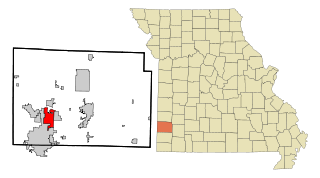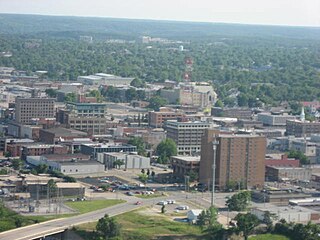Related Research Articles

Ottawa County is a county located in the northeastern corner of the U.S. state of Oklahoma. As of the 2020 census, the population was 30,285. Its county seat is Miami. The county was named for the Ottawa Tribe of Oklahoma. It is also the location of the federally recognized Modoc Nation and the Quapaw Nation, which is based in Quapaw.

St. Francois County is a county located in the Lead Belt region in the U.S. state of Missouri. As of the 2020 census, the population was 66,922. The largest city and county seat is Farmington. The county was officially organized on December 19, 1821. It was named after the St. Francis River. The origin of the river's name is unclear. It might refer to St. Francis of Assisi. Another possibility is that Jacques Marquette, a Jesuit who explored the region in 1673, named the river for the Jesuit missionary Francis Xavier. Marquette had spent some time at the mission of St. François Xavier before his voyage and, as a Jesuit, was unlikely to have given the river a name honoring the Franciscans.

Galena is a city in Cherokee County, Kansas, United States. As of the 2020 census, the population of the city was 2,761.

Webb City is a city in Jasper County, Missouri, United States. The population was 13,031 at the 2020 census. It is part of the Joplin, Missouri Metropolitan Statistical Area. Webb City also has a police department, a fire department, and animal control services.

Granby is a city in Newton County, Missouri, United States. The population was 2,134 at the 2010 census. It is part of the Joplin, Missouri Metropolitan Statistical Area.

Peoria is a town in Ottawa County, Oklahoma, United States. It was named for the Peoria people, a tribe of Native Americans who were removed to Indian Territory from east of the Mississippi River during the 19th century. The territory had been occupied by the Quapaw people, who sold some of their land to the Peoria.

Picher is a ghost town and former city in Ottawa County, northeastern Oklahoma, United States. It was a major national center of lead and zinc mining for more than 100 years in the heart of the Tri-State Mining District.

Joplin is a city in Jasper and Newton counties in the southwestern corner of the U.S. state of Missouri. The bulk of the city is in Jasper County, while the southern portion is in Newton County. Joplin is the largest city located within both Jasper and Newton Counties – even though it is not the county seat of either county. With a population of 51,762 as of the 2020 census, Joplin is the 13th most-populous city in the state. The city covers an area of 35.69 square miles (92.41 km2) on the outer edge of the Ozark Mountains. Joplin is the main hub of the three-county Joplin-Miami, Missouri-Oklahoma Metro area, which is home to 210,077 people making it the 5th largest metropolitan area in Missouri. In May 2011, the city was hit by a violent EF5 tornado which destroyed one-third of the city.

Galena, also called lead glance, is the natural mineral form of lead(II) sulfide (PbS). It is the most important ore of lead and an important source of silver.

The Southeast Missouri Lead District, commonly called the Lead Belt, is a lead mining district in the southeastern part of Missouri. Counties in the Lead Belt include Saint Francois, Crawford, Dent, Iron, Madison, Reynolds, and Washington. This mining district is the most important and critical lead producer in the United States.
The four-state area or quad-state area, is the area where the states of Arkansas, Kansas, Missouri, and Oklahoma almost touch: Arkansas and Kansas share no boundary. The Tulsa, Oklahoma; Joplin, Missouri; and Fayetteville–Springdale–Rogers, Arkansas, metropolitan areas are located within the region. Notable cities and towns in the area are Tulsa and Miami, Oklahoma; Pittsburg, Kansas; Joplin, Springfield, and Monett, Missouri; and Fayetteville, Springdale, Rogers, and Bentonville, Arkansas.
Joplin Public Library District is the library services for Joplin, Missouri.
Eagle-Picher Technologies is a privately held, American, manufacturing company known for its battery technology, energetic devices and battery management systems. The company started in 1843 as the White Lead Company in Cincinnati, Ohio. A merger with the Picher Lead Company of Joplin, Missouri occurred in 1906, becoming Eagle–Picher Lead, which evolved into Eagle–Picher Industries, Inc. and finally EaglePicher Technologies. With its merger with the lead mining company owned by Oliver Picher, it was the second largest producer of lead and zinc products in the world. The company has provided lithium-ion batteries to military aircraft and high altitude unmanned aerial vehicles. EaglePicher also developed the first human-implantable lithium-ion battery. The company has nine North American manufacturing and research and development sites and over 900 employees.

The Tri-State district was a historic lead-zinc mining district located in present-day southwest Missouri, southeast Kansas and northeast Oklahoma. The district produced lead and zinc for over 100 years. Production began in the 1850s and 1860s in the Joplin - Granby area of Jasper and Newton counties of southwest Missouri. Production was particularly high during the World War I era and continued after World War II, but with declining activity. As jobs left the area, the communities declined in population.
The Arizona Mining and Mineral Museum in Phoenix, Arizona, was a museum focused on minerals and mining. Last operated by the Arizona Historical Society, a state government agency, its exhibits included more than 3,000 minerals, rocks, fossils, and artifacts related to the mining industry. The museum closed in May 2011. In April 2017, legislation was passed to reopen the museum under the ownership of the University of Arizona.
The Desloge family, centered mostly in Missouri and especially at St. Louis, rose to wealth through international commerce, sugar refining, oil drilling, fur trading, mineral mining, saw milling, manufacturing, railroads, real estate, and riverboats. The family has funded hospitals and donated large tracts of land for public parks and conservation.
Prosperity is an unincorporated community in Jasper County, in the U.S. state of Missouri. It is northeast of Joplin and just southeast of Webb City, sitting east of Missouri State Highway 249.
Mineral Township is an inactive township in Jasper County, in the U.S. state of Missouri.
Adelbert is an extinct town in Washington County, in the U.S. state of Missouri. The site is adjacent to the Missouri Pacific Railroad line on the west side of Mill Creek and one mile north of Mineral Point and southeast of Fountain Farm. Cadet lies approximately two miles to the northeast on Missouri Route 47.
References
- ↑ "Joplin History & Mineral Museum". joplin-museum.org. Joplin History and Mineral Museum. 2021. Retrieved May 8, 2023.
- ↑ "Our Story". joplin-museum.org. Joplin History and Mineral Museum. Retrieved May 8, 2023.
- ↑ Price, Stuart (January 11, 2023). "What's new at Joplin's History and Mineral Museum?". KSNF. Joplin, Missouri. Retrieved May 8, 2023.